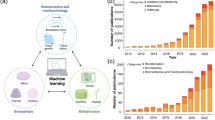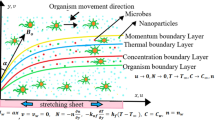Abstract
The application of three-dimensional (3D) biomaterials to facilitate the adhesion, proliferation, and differentiation of cells has been widely studied for tissue engineering purposes. The fabrication methods used to improve the mechanical response of the scaffold produce complex and non regular structures. Apart from the mechanical aspect, the fluid behavior in the inner part of the scaffold should also be considered. Parameters such as permeability (k) or wall shear stress (WSS) are important aspects in the provision of nutrients, the removal of metabolic waste products or the mechanically-induced differentiation of cells attached in the trabecular network of the scaffolds. Experimental measurements of these parameters are not available in all labs. However, fluid parameters should be known prior to other types of experiments. The present work compares an experimental study with a computational fluid dynamics (CFD) methodology to determine the related fluid parameters (k and WSS) of complex non regular poly(l-lactic acid) scaffolds based only on the treatment of microphotographic images obtained with a microCT (μCT). The CFD analysis shows similar tendencies and results with low relative difference compared to those of the experimental study, for high flow rates. For low flow rates the accuracy of this prediction reduces. The correlation between the computational and experimental results validates the robustness of the proposed methodology.












Similar content being viewed by others
References
Acosta Santamaría, V., H. Deplaine, D. Mariggió, A. R. Villanueva-Molines, J. M. García-Aznar, J. L. Gómez Ribelles, M. Doblaré, G. Gallego Ferrer, and I. Ochoa. Influence of the macro and micro-porous structure on the mechanical behavior of poly(l-lactic acid) scaffolds. J. Non-Cryst. Solids 358(23):3141–3149, 2012.
Adachi, T., Y. Osako, M. Tanaka, M. Hojo, and S. J. Hollister. Framework for optimal design of porous scaffold microstructure by computational simulation of bone regeneration. Biomaterials 27(21):3964–3972, 2006.
Adamczyk, Z., and T. G. M. Vandeven. Deposition of particles under external forces in laminar-flow through parallel-plate and cylindrical channels. J. Colloid Interface Sci. 80(2):340–356, 1981.
Alberich, B. A., D. Moratal, J. L. Escobar, J. C. Rodríguez, A. Vallés-Lluch, L. Martí-Bonmatí, et al. Microcomputed tomography and microfinite element modeling for evaluating polymer scaffolds architecture and their mechanical properties. J. Biomed. Mater. Res. B Appl. Biomater. 91B(1):191–202, 2009.
Al-Munajjed, A., M. Hien, R. Kujat, J. P. Gleeson, and J. Hammer. Influence of pore size on tensile strength, permeability and porosity of hyaluronan-collagen scaffolds. J. Mater. Sci. Mater. Med. 19(8):2859–2864, 2008.
Alves da Silva, M. L., A. Martins, A. R. Costa-Pinto, V. M. Correlo, P. Sol, M. Bhattacharya, S. Faria, R. L. Reis, and N. M. Neves. Chondrogenic differentiation of human bone marrow mesenchymal stem cells in chitosan-based scaffolds using a flow-perfusion bioreactor. J. Tissue Eng. Regen. Med. 5(9):722–732, 2011.
Ansys (2010) CFX Theory User Manual. Canonsburg, PA: Ansys Software.
Brígido, R. D., J. M. Estellés, J. A. Sanz, J. M. García-Aznar, and M. S. Sánchez. Polymer scaffolds with interconnected spherical pores and controlled architecture for tissue engineering: fabrication, mechanical properties, and finite element modeling. J. Biomed. Mater. Res. B Appl. Biomater. 81B(2):448–455, 2007.
Byrne, P. D., D. Lacroix, J. A. Planell, D. J. Kelly, and P. J. Prendergast. Simulation of tissue differentiation in a scaffold as a function of porosity, Young’s modulus and dissolution rate: application of mechanobiological models in tissue engineering. Biomaterials 28:5544–5554, 2007.
Chor, M. V., and W. Li. A permeability measurement system for tissue engineering scaffolds. Meas. Sci. Technol. 18(1):208–216, 2007.
Cozensroberts, C., J. A. Quinn, and D. A. Lauffenburger. Receptor-mediated adhesion phenomena—model studies with the radial-flow detachment assay. Biophys. J. 58(1):107–125, 1990.
Davisson, T., R. L. Sah, and A. Ratcliffe. Perfusion increases cell content and matrix synthesis in chondrocyte three-dimensional cultures. Tissue Eng. 8(5):807–816, 2002.
Deplaine, H., M. Lebourg, P. Ripalda, A. Vidaurre, P. Sanz-Ramos, G. Mora, F. Prósper, I. Ochoa, M. Doblaré, J. L. Gómez Ribelles, I. Izal-Azcárate, and G. Gallego Ferrer. Biomimetic hydroxyapatite coating on pore walls improves osteointegration of poly(l-lactic acid) scaffolds. J. Biomed. Mater. Res. B Appl. Biomater. 101(1):173–186, 2013.
Dias, M. R., P. R. Fernandes, J. M. Guedes, and S. J. Hollister. Permeability analysis of scaffolds for bone tissue engineering. J. Biomech. 45(6):938–944, 2012.
Freyman, T. M., I. V. Yannas, and L. J. Gibson. Cellular materials as porous scaffolds for tissue engineering. Prog. Mater Sci. 46:273–282, 2001.
Gong, S., H. Wang, Q. Sun, S. T. Xue, and J. Wang. Mechanical properties and in vitro biocompatibility of porous zein scaffolds. Biomaterials 27(20):3793–3799, 2006.
Gutierrez, R. A., and E. T. Crumpler. Potential effect of geometry on wall shear stress distribution across scaffold surfaces. Ann. Biomed. Eng. 36(1):77–85, 2008.
Hammer, D. A., and D. Lauffenburger. A dynamic-model for receptor-mediated cell adhesion to surfaces. Biophys. J. 52(3):475–487, 1987.
Ho, S. T., and D. W. Hutmacher. A comparison of micro CT with other techniques used in the characterization of scaffolds. Biomaterials 27(8):1362–1376, 2006.
Ho, M. H., P. Y. Kuo, H. J. Hsieh, T. Y. Hsien, L. T. Hou, J. Y. Lai, and D. M. Wang. Preparation of porous scaffolds by using freeze-extraction and freeze-gelation methods. Biomaterials 25(1):129–138, 2004.
Hutmacher, D. W., J. T. Schantz, C. X. Lam, K. C. Tan, and T. C. Lim. State of the art and future directions of scaffold-based bone engineering from a biomaterials perspective. J. Tissue Eng. Regen. Med. 1(4):245–260, 2007.
Izal, I., P. Aranda, P. Sanz-Ramos, P. Ripalda, G. Mora, F. Granero-Moltó, H. Deplaine, J. L. Gómez-Ribelles, G. G. Ferrer, V. Acosta, I. Ochoa, J. M. García-Aznar, E. J. Andreu, M. Monleón-Pradas, M. Doblaré, and F. Prósper. Culture of human bone marrow-derived mesenchymal stem cells on of poly(l-lactic acid) scaffolds: potential application for the tissue engineering of cartilage. Knee Surg. Sports Traumatol. Arthrosc., 2012.
Kapur, S., D. J. Baylink, and K. H. Lau. Fluid flow shear stress stimulates human osteoblast proliferation and differentiation through multiple interacting and competing signal transduction pathways. Bone 32(3):241–251, 2003.
Karande, T. S., J. L. Ong, and C. M. Agrawal. Diffusion in musculoskeletal tissue engineering scaffolds: design issues related to porosity, permeability, architecture, and nutrient mixing. Ann. Biomed. Eng. 32(12):1728–1743, 2004.
Kelly, D. J., and P. J. Prendergast. Mechano-regulation of stem cell differentiation and tissue regeneration in osteochondral defects. J. Biomech. 38(7):1413–1422, 2005.
Kreke, M. R., L. A. Sharp, Y. W. Lee, and A. S. Goldstein. Effect of intermittent shear stress on mechanotransductive signaling and osteoblastic differentiation of bone marrow stromal cells. Tissue Eng. Part A 14(4):529–537, 2008.
Lacroix, D., A. Chateau, M. P. Ginebra, and J. A. Planell. Micro-finite element models of bone tissue-engineering scaffolds. Biomaterials 27(30):5326–5334, 2006.
Lacroix, D., and P. J. Prendergast. A mechano-regulation model for tissue differentiation during fracture healing: analysis of gap size and loading. J. Biomech. 35(9):1163–1171, 2002.
Li, S., J. R. De Wijn, J. Li, P. Layrolle, and K. De Groot. Macroporous biphasic calcium phosphate scaffold with high permeability/porosity ratio. Tissue Eng. 9:535–548, 2003.
Melchels, F. P. W., B. Tonnarelli, A. L. Olivares, I. Martin, D. Lacroix, J. Feijen, et al. The influence of the scaffold design on the distribution of adhering cells after perfusion cell seeding. Biomaterials 32(11):2878–2884, 2011.
O’Brien, F. J., B. A. Harley, M. A. Waller, I. Yannas, L. J. Gibson, and P. Prendergast. The effect of pore size on permeability and cell attachment in collagen scaffolds for tissue engineering. Technol. Health Care 15(1):3–17, 2007.
Ochoa, I., J. A. Sanz, J. M. Garcia-Aznar, M. Doblare, D. M. Yunos, and A. R. Boccaccini. Permeability evaluation of 45S5 bioglass-based scaffolds for bone tissue engineering. J. Biomech. 42:257–260, 2009.
Porter, B., R. Zauel, H. Stockman, R. Guldberg, and D. Fyhrie. 3-D computational modeling of media flow through scaffolds in a perfusion bioreactor. Mater. Res. 38:543–549, 2005.
Sandino, C., S. Checa, P. J. Prendergast, and D. Lacroix. Simulation of angiogenesis and cell differentiation in a CaP scaffold subjected to compressive strains using a lattice modeling approach. Biomaterials 31(8):2446–2452, 2010.
Sanz, J. A., J. M. García-Aznar, and M. Doblaré. On scaffold designing for bone regeneration: a computational multiscale approach. Acta Biomater. 5(1):219–229, 2009.
Sanz, J. A., C. Kasper, M. van Griensven, J. M. Garcia-Aznar, I. Ochoa, and M. Doblare. Mechanical and flow characterization of Sponceram® carriers: evaluation by homogenization theory and experimental validation. J. Biomed. Mater. Res. B Appl. Biomater. 87B(1):42–48, 2008.
Singh, H., S. H. Teoh, H. T. Low, and D. W. Hutmacher. Flow modelling within a scaffold under the influence of uni-axial and bi-axial bioreactor rotation. J. Biotechnol. 119:181–196, 2005.
Sjollema, J., and H. J. Busscher. Deposition of polystyrene latex-particles toward polymethylmethacrylate in a parallel plate flow cell. J. Colloid Interface Sci. 132(2):382–394, 1989.
Truscello, S., G. Kerckhofs, S. Van Bael, G. Pyka, J. Schrooten, and H. Van Oosterwyck. Prediction of permeability of regular scaffolds for skeletal tissue engineering: a combined computational and experimental study. Acta Biomater. 8(4):1648–1658, 2012.
Woodfield, T. B., J. Malda, J. Wijn, F. Péters, J. Riesle, and C. A. van Blitterswijk. Design of porous scaffolds for cartilage tissue engineering using a three-dimensional fiber-deposition technique. Biomaterials 25(18):4149–4161, 2004.
Acknowledgments
The authors gratefully acknowledge research support from the Spanish Ministry of Science and Innovation through research project DPI2010-20399-C04-01. The Instituto de Salud Carlos III (ISCIII) through the CIBER initiative and the Platform for Biological Tissue Characterization of the Centro de Investigación Biomédica en Red en Bioingeniería, Biomateriales y Nanomedicina (CIBER-BBN) are also gratefully acknowledged.
Author information
Authors and Affiliations
Corresponding author
Additional information
Associate Editor Stefan Jockenhoevel oversaw the review of this article.
Rights and permissions
About this article
Cite this article
Acosta Santamaría, V.A., Malvè, M., Duizabo, A. et al. Computational Methodology to Determine Fluid Related Parameters of Non Regular Three-Dimensional Scaffolds. Ann Biomed Eng 41, 2367–2380 (2013). https://doi.org/10.1007/s10439-013-0849-8
Received:
Accepted:
Published:
Issue Date:
DOI: https://doi.org/10.1007/s10439-013-0849-8




